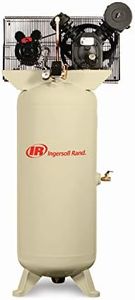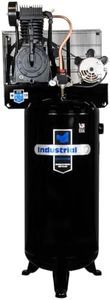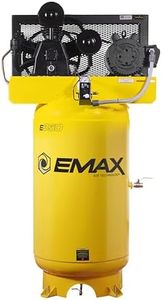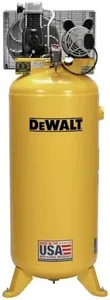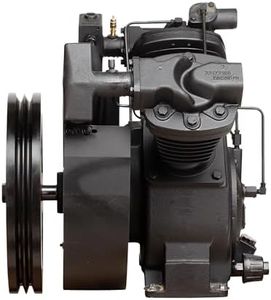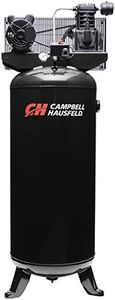8 Best 60 Gallon Air Compressors 2025 in the United States
Our technology thoroughly searches through the online shopping world, reviewing hundreds of sites. We then process and analyze this information, updating in real-time to bring you the latest top-rated products. This way, you always get the best and most current options available.

Our Top Picks
Winner
Ingersoll Rand 2340L5-V 5 hp Type 30 2 Stage Reciprocating Compressor
Most important from
31 reviews
The Ingersoll Rand 2340L5-V is a robust 60-gallon air compressor designed primarily for industrial applications, boasting a powerful 5 horsepower motor with a maximum operating pressure of 175 PSI. One of its standout features is the high air flow capacity of 14 CFM, which allows for efficient operation, especially in demanding tasks. The durable cast iron construction not only enhances longevity but also ensures it can handle continuous duty without interruptions, making it suitable for serious users who require reliability.
On the maintenance side, its individually cast cylinders and one-piece connecting rod design make servicing more straightforward, an important factor for users who may need to perform their upkeep. Additionally, the automatic shut-off feature provides peace of mind, preventing potential overpressure situations.
This model does come with some drawbacks. With a noise level of 85 dB, it may be louder than some users would prefer, so those sensitive to noise might want to consider ear protection or alternative options for quieter operation. Furthermore, its weight of 430 pounds indicates limited portability; this compressor is best suited for a fixed installation rather than frequent relocation. Finally, the 230-volt requirement means that users will need to ensure they have the appropriate electrical setup to operate it, which could be a challenge for some home users or those in areas with standard 120-volt outlets.
The Ingersoll Rand 2340L5-V is a strong candidate for industrial users needing a reliable, powerful compressor for high-demand tasks, although it may not be the best fit for casual users or those requiring portability and low noise levels.
Most important from
31 reviews
Industrial Air IV5076055 60 gallon 5 hp Two Stage Air Compressor
Most important from
26 reviews
The Industrial Air IV5076055 is a robust 60-gallon air compressor designed for industrial performance with a powerful 5 HP motor. Its notable strength is the high CFM rating, delivering 15.3 SCFM at 100 PSI and 13.5 SCFM at 175 PSI. This high output allows users to operate multiple air tools simultaneously, making it suitable for demanding tasks such as drilling, air brushing, spraying, and nailing. Additionally, the two-stage compressor with a patented pump design ensures cooler operation and longer life, enhanced by its low pump RPM feature.
The large 60-gallon ASME tank and a 3/4” outlet port further contribute to its efficient performance. Users will also appreciate the electric motor with thermal overload protection for added safety and reliability. The unit comes equipped with essential features like a tank pressure gauge, on/off switch, and a wire form belt guard for better cooling. Despite its capabilities, one should note that it is quite heavy at 400 pounds, which may limit its portability despite being labeled as such. However, the four tie-down holes do assist in transportation.
It is covered by a 2-year limited warranty and operates at 230 volts. This compressor is ideal for professionals needing a reliable and efficient machine for heavy-duty applications but might not be the best choice for those seeking extreme portability or quieter operation.
Most important from
26 reviews
EMAX Electric Air Compressor - 80 Gal 5HP 2 Stage Compressor with Auto Drain & 17 CFM, 200 Max PSI - EHI05V080Y1
Most important from
5 reviews
The EMAX Electric Air Compressor is a high-capacity machine ideal for demanding industrial applications. It features a powerful 5 HP motor that delivers 17 CFM at 100 PSI, and can reach a maximum of 200 PSI, ensuring strong and consistent airflow for heavy-duty tasks like drilling, nailing, and sanding. The compressor's 80-gallon tank is made of durable steel and designed to withstand rigorous use, backed by a splash-lubricated pump meant to last up to 50,000 hours, ensuring longevity and reliable performance.
One of the standout features is the manual tank drain system, which, while requiring user intervention, contributes to the product's low maintenance needs and ensures proper upkeep. This compressor is stationary and quite heavy, weighing 770 pounds, which limits its portability but adds to its robustness for industrial use. Additionally, it boasts an all-cast iron pump and heavy-duty construction, further enhancing its durability.
Built and rigorously tested in Ohio, the compressor reflects a commitment to quality and comes with a strong warranty.
Most important from
5 reviews
Buying Guide for the Best 60 Gallon Air Compressors
Choosing the right 60-gallon air compressor can significantly impact the efficiency and effectiveness of your work, whether you're using it for professional tasks or DIY projects. The key is to understand the various specifications and how they align with your specific needs. By focusing on the right specs, you can ensure that you get a compressor that meets your requirements without overpaying for features you don't need.FAQ
Most Popular Categories Right Now
